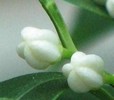Fertilizer type can affect tree size. Fertilization with ammoniacal nitrogen (NH4+) tends to cause greater petiole and stem elongation, and greater leaf expansion. In contrast, fertilization with nitrate nitrogen tends to have shorter petioles and stems and smaller leaves. The color of the tree may also be affected by the form of nitrogen used. Plants fertilized with ammoniacal nitrogen tend to be darker green than plants grown with nitrate nitrogen. With the current state of knowledge, it is impossible to determine how much of the "ammoniacal nitrogen" effect is due to higher levels of phosphorus, or whether it is due to lower pH.
It is also important to know that the light level also interacts with the form of nitrogen to affect tree growth. Growers typically use a fertilizer that is high in nitrate nitrogen when the light levels are low-- (from November to March in most parts of the country) -- when short compact growth is desired.
When the light levels increase in late spring and summer, growers generally switch to fertilizers that contain higher levels of ammoniacal nitrogen when more lush growth is acceptable and the higher light levels will also help keep plants short. Be aware that switching from a nitrate based fertilizer to an ammoniacal based fertilizer in the spring will tend to make the medium pH drop and water alkalinity may need to be adjusted accordingly by reducing water acidification (if needed). Taken from "Understanding pH Management For Container-Grown Crops" by William R Argo & Paul R. Fisher - Millet (455-)





